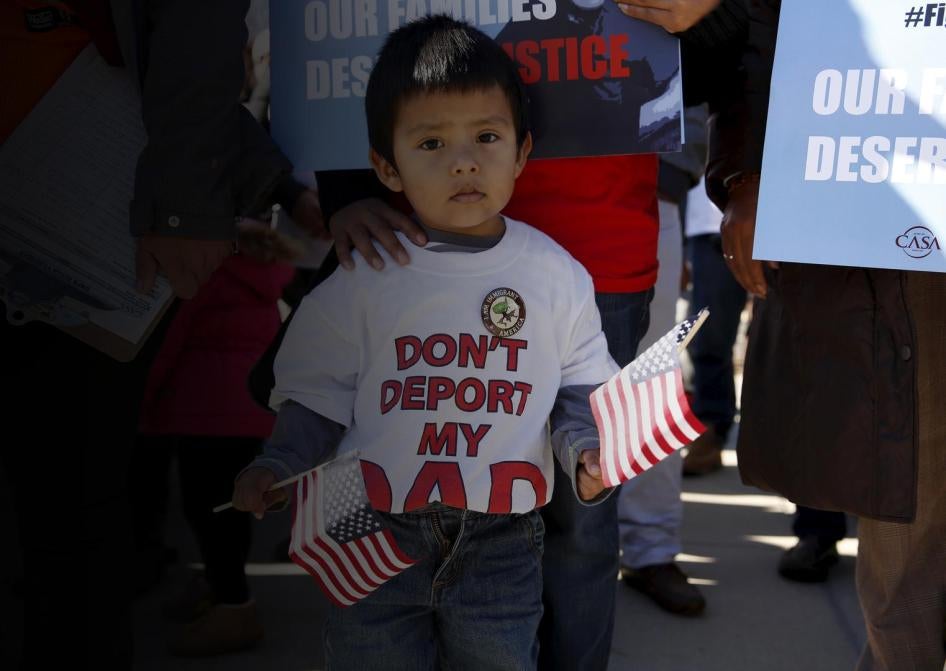President-elect Donald Trump has said that he intends to deport or “incarcerate” 2 million or “even 3 million” non-citizens “that are criminal and have criminal records, gang members, drug dealers.” Who are these people likely to be, and what would be the human rights impact of deporting them? These questions and answers explore those issues.
Are there really 2 to 3 million non-citizens with criminal histories to deport?
It depends on what you mean by criminal and which non-citizens might be affected. Most people think of the threat of deportation as hanging over the heads of non-citizens who live in the United States without authorization. But many of those who have been deported from locations around the country are actually legal US residents who have been convicted of a crime. In 2012, the Department of Homeland Security (DHS) estimated that there were 11.4 million unauthorized immigrants in the US and 13.3 million lawful permanent residents, or green card holders, plus a couple of million non-citizen visitors such as students with time-limited legal permission to remain in the country.
Trump may be getting his estimate from a DHS budget request for fiscal year 2013 that lumped these categories together, saying there were probably 1.9 million criminal “removable aliens” in the US – based on an agency estimate that they have some criminal history. When DHS uses the term “removable alien” it refers both to non-citizens without lawful immigration status and to those who have lawful status that could be revoked.
A non-partisan research organization, the Migration Policy Institute, has estimated that based on population size, it’s likely that about 820,000 of the 1.9 million “criminal removable aliens” do not have legal status. So the remainder, 57 percent, are people who are in the country lawfully and more likely to be long-term residents with families, lives, and ties to communities in the US.
Okay, so maybe the numbers are fuzzy, but shouldn’t “criminals” be deported?
It is important to understand that in this context, the term “criminals” doesn’t mean what many people might assume. It includes people who are guilty only of extremely minor offenses, and people whose only criminal offense is entering the country illegally. Some people deported as “criminals” long ago served their time and have changed their lives. Many know no other country because they came legally or illegally as children. They are part of US communities, churches, work places, and families. They are military veterans, blue-collar workers, and owners of businesses and homes. In many cases, already-existing US law harshly mandates their detention and deportation without consideration of these factors.
Human Rights Watch’s experience documenting the impact of “criminal alien” deportations over the last decade is instructive. The Obama administration claimed that it was focused, as President Barack Obama said, on “criminals, gang bangers, [and] people who are hurting the community.” Instead, deportations under Obama included hundreds of thousands of people deported for minor crimes, people who had no convictions at all but were swept up in immigration enforcement anyway, and hundreds of thousands of people whose most serious crime was an immigration violation. The New York Times found in 2014 that two-thirds of the nearly 2 million people the Obama administration had deported involved people who had committed minor infractions, including traffic violations, or had no criminal record.
This was not a new trend. Human Rights Watch’s analysis of US government data reveals that 72 percent of non-citizens deported for criminal convictions from 1997 to 2007 had nonviolent offenses. More than 1 million family members were affected by these deportations. Human Rights Watch analyses of government data in 2009 and 2013 also showed that hundreds of thousands of people with minor nonviolent criminal convictions and with strong family ties in the US were swept up into detention and deportation.
A large proportion of these nonviolent offenses also involved immigration offenses and drugs. From 2007 to 2012, Human Rights Watch calculated that deportations of people whose most serious conviction was for drug possession spiked, increasing 43 percent. These deportations often involve people whose crime had occurred in the distant past. For example, the US government in 2010 began deportation proceedings against Marsha Austin, a grandmother from Jamaica and a permanent resident living in the Bronx, New York, as a “drug trafficker” for a 1995 conviction for buying crack cocaine for an undercover police officer. She is now in recovery from her dependence on drugs.
When it comes to people without lawful status, Trump has indicated that his immigration enforcement officials would target people “who are arrested for any crime whatsoever,” and place them “into immediate removal proceedings if we even have to do that.” That could mean that immigration officials would try to deport any non-citizen who had ever been arrested – regardless of how serious their alleged crime was or whether they had been convicted, trampling upon their rights to a presumption of innocence and to fair deportation proceedings.
What about people whose only offense was to enter the country illegally?
Under the Obama administration, the most common category of criminal conviction triggering deportation proceedings became immigration offenses.
In 2015, immigration prosecutions made up 40 percent of all federal criminal cases. Prosecutions for illegal entry and reentry, both nonviolent offenses, are up 182 percent and 87 percent compared with 10 years ago. Whereas criminal prosecution used to be reserved for those with the most serious criminal histories, in 2015, 30 percent of people sentenced under the Sentencing Guideline for illegal re-entry had no criminal record, or had a record so minor it did not trigger an increase in the sentence.
According to federal judges, prosecutors, and defense attorneys, many of those prosecuted for illegal re-entry are long-term residents of the US, including former lawful permanent residents, who are desperate to return or remain with their US citizen family members, including minor US citizen children. Federal district Judge Robert Brack, who has sentenced over 11,000 people for illegal re-entry, told Human Rights Watch, “For 10 years now, I’ve been presiding over a process that destroys families every day and several times each day.”
Though most prosecutions for illegal entry and re-entry start at the border, some US attorneys in non-border states also file charges against unauthorized immigrants, and that practice could ramp up under Trump. During his campaign, Trump promised to “incarcerate” criminal aliens and promote legislation that would impose a mandatory minimum sentence of two years in federal prison for people caught in the US after being deported. Those who return after being deported twice would face a minimum of five years.
These prosecutions are already more likely to affect people who have built lives in the US. Human Rights Watch analysis of government data from 2011 and 2012 found that parents of US citizen children are much more likely than non-parents to be deported at the border multiple times and to be prosecuted for illegal entry and re-entry. And of course, such mass immigration prosecutions draw federal criminal justice resources away from people who represent a real threat to public safety or national security.
Trump has suggested he plans to deport millions of criminals “immediately.” Is that possible?
Deporting 2 to 3 million people “immediately” would be very hard to do while respecting their rights. Even with over half of the $41 billion DHS budget devoted to immigration enforcement, the US government has deported between 235,000 and 409,000 people a year every year since 2008.
One way that the incoming administration may want to speed up immigration enforcement resources is by using local police forces to enforce immigration law. In the past, such efforts have undermined the trust between communities and law enforcement and failed to identify many people with serious criminal convictions.
Instead, the programs terrified unauthorized immigrants – to the point at which they avoided the police even when they desperately need police protection. That means that crimes aren’t reported, investigated, or prosecuted. As San Francisco District Attorney George Gascón has said, “When victims are afraid to come forward and cooperate with authorities because of their immigration status the whole community suffers.”
Many of those sent for deportation from the interior of the country have a right to a hearing before an immigration judge. With only 374 immigration judge positions funded (and fewer still occupied), that system is massively overloaded, with hearings often scheduled up to five years in advance. This slows down the process. Another way Trump has suggested his administration might speed things up is to strip more people from the interior of their right to a hearing by expanding a procedure called “expedited removal.” Expedited removal is now only applicable to people caught within 100 miles of the border and within 14 days of their entry into the US.
Extending that system to people in the interior of the country would greatly expand the scope and impact of a system that has proven itself to be callous, arbitrary and badly in need of reform. Human Rights Watch has found that under the rapid-fire, rubber-stamp system of expedited removed hearings, immigration officials fail to apply the safeguards against deporting those who face persecution or torture if deported to their home countries. Expedited removal also gives people no chance to present to an immigration judge evidence of their ties to the country, their family, or other mitigating factors.
But what if an immigrant is released from detention and commits a serious crime?
An immigrant who commits a serious, violent crime should be held accountable like anyone else. The US criminal justice system exists to ensure that happens. However, the actions of a few people should not be used to scapegoat whole communities – including people whose only offense may be entering the country to try to reunite with family, or who served their time decades ago and changed their lives. Over the long term, an increase in the unauthorized population has not led to a higher violent crime rate. The undocumented population more than tripled from 1990-2013, whereas FBI data indicates that the violent crime rate declined 48 percent over the same time period.
Still, deporting millions of “criminals” does not have the potential to be the same as “mass deportation,” right?
Wrong. It can cause the same economic impact, traumatized families, and pervasive rights violations. We have documented how these deportations have harmed military veterans, parents, children, business owners, students, people who have lived in the country since childhood, and others. But there are other types of harm from large scale deportation. In the first six years of the Obama administration, officials deported 2 million people. New research suggests that at the height of the great recession, counties in which local police signed agreements with federal officials to enforce immigration law experienced a surge in foreclosures of homes owned by Hispanics. That is a powerful reminder that those targeted for deportation live with families and in households with legal residents and American citizens.
The impact on families must also be underscored. Human Rights Watch has documented scores of cases of families torn apart by deportation and detention. These families include former US service members like Hilarion Joseph, a decorated veteran of the first Gulf War and a long-time lawful permanent resident. Joseph suffered from post-traumatic stress disorder after the war and attempted suicide three times. He made decisions he sincerely regrets, which led to a conviction for transporting guns without a license for which he was put on probation. But during an effort to deport him, immigration authorities locked him up for three years away from his family. Since his release, he has focused on raising his son as a single parent. Recently, he became a US citizen.
Trump’s deportation plan also has the potential to further reduce the limited due process protections afforded to non-citizens in deportation proceedings. The current system already locks up many people and then makes them fight against trained government lawyers without the assistance of an attorney. Immigrants often have strong defenses against deportation and avenues to legal status under existing law, but are detained and deported without any meaningful opportunity to present those claims, let alone get access to counsel. Trump’s proposals would appear to only aggravate this already existing unfair process and to risk significant numbers of wrongful deportations.









